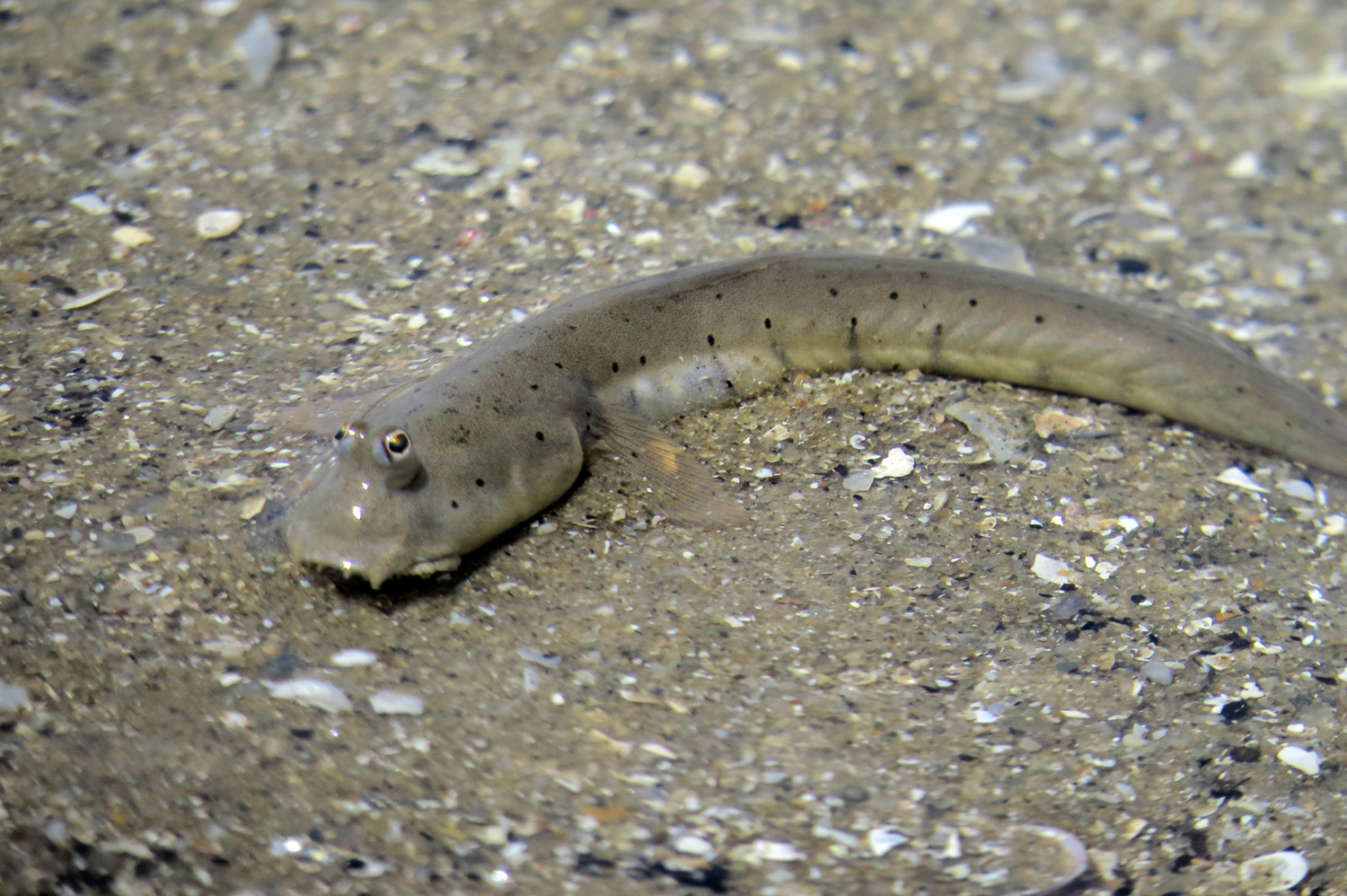- Classification
- ACTINOPTERYGII
- PERCIFORMES
- GOBIIDAE
- Scartelaos
- histophorus
Bearded Mudskipper, Scartelaos histophorus (Valenciennes 1837)
Other Names: Bearded Goby, Blue Mud-hopper

A Bearded Mudskipper, Scartelaos histophorus, on mudflats along waterfront at North Cairns, Queensland, September 2014. Source: coenobita / iNaturalist.org. License: CC by Attribution-NonCommercial
Summary:
A slender greenish-grey mudskipper with narrow dark grey to bluish bars along the side, narrow dark wavy bars and a black margin on the caudal fin, bluish to black speckles scattered on the cheek and body, tiny bluish spots on the second dorsal fin, and males with a white ring around the eye (in Australia). Species of Scartelaos have barbels on the underside of the head.
Cite this page as:
Bray, D.J., 2016, Scartelaos histophorus in Fishes of Australia, accessed 17 Apr 2024, https://fishesofaustralia.net.au/home/species/157
Bearded Mudskipper, Scartelaos histophorus (Valenciennes 1837)
More Info
|
Distribution |
Broome, Western Australia, to Brisbane, Queensland. Elsewhere the species occurs in the tropical, Indo-west Pacific. Inhabits tidal mud flats and pneumatophores zones amongst mangroves. |
|
Features |
Head depth 10.1-12.4%SL; caudal fin length 18.5-25.1%SL; length of first dorsal-fin base 5.7-7.5%SL; second dorsal and anal fins connected by membrane to the caudal fin; barbel on tip of chin (ventral midline), near the symphysis of lower jaw. |
|
Colour |
Ground colour on dorsum and flanks greenish grey: dorsally darker; venter pale blue to whitish; cheek and trunk with scattered bluish to black speckles; 4-8 dark grey to bluish, narrow vertical bars frequently on sides; D1 greenish grey; D2 dusky to greenish grey with tiny bluish spots; caudal fin grey with 3-5 black wavy, broken lines, posterior margin black; anal fin transparent; pectoral and pelvic fins dusky; males of Australian populations have white eye borders; no large, black spots or stripes basally on posterior half of D2. (Polgar / http://www.mudskipper.it/SpeciesPages/hist.html) |
|
Feeding |
Omnivore - feeds on diatoms and small invertebrates such as nematodes, ostracods, and copepods. |
|
Biology |
The sexes are separate and males attract females to their burrows at low tide by "standing" on their tails. |
|
Etymology |
The specific name histophorus is from the Greek 'hystos' (pole, mast), and 'phorein' (to bear, to wear), in reference to the narrow, pointed first dorsal fin. |
|
Species Citation |
Boleophthalmus histophorus Valenciennes in Cuvier & Valenciennes 1837, Hist. Nat. Poiss. 12: 210. Type locality: Bombay& the Ganges River, India (syntypes). |
|
Author |
Bray, D.J., 2016 |
|
Resources |
Bearded Mudskipper, Scartelaos histophorus (Valenciennes 1837)
References
Allen, G.R. 1997. Marine Fishes of Tropical Australia and South-east Asia. Perth : Western Australian Museum 292 pp. 106 pls.
Allen, G.R. & Swainston, R. 1988. The Marine Fishes of North-Western Australia. A field guide for anglers and divers. Perth, WA : Western Australian Museum vi 201 pp., 70 pls.
Castelnau, F.L. de 1873. Contribution to the ichthyology of Australia. 5. Notes on fishes from north Australia. Proceedings of the Zoological and Acclimatisation Society of Victoria 2: 83-97 ( as Apocryptes macrophthalmus)
De Vis, C.W. 1884. Fishes from South Sea islands. Proceedings of the Linnean Society of New South Wales 1 8(4): 445-457 (as Gobiosoma punctularum)
Grant, E.M. 1975. Guide to Fishes. Brisbane : Queensland Government, Co-ordinator General’s Department 640 pp.
Hamilton, F. 1822. An Account of the Fishes Found in the River Ganges and its Branches. Edinburgh : Archibald) Constable 405 pp., pls 1-39. (as Gobius viridis)
Johnson, J.W. 2010. Fishes of the Moreton Bay Marine Park and adjacent continental shelf waters, Queensland, Australia. pp. 299-353 in Davie, P.J.F. & Phillips, J.A. Proceedings of the Thirteenth International Marine Biological Workshop, The Marine Fauna and Flora of Moreton Bay. Memoirs of the Queensland Museum 54(3)
Larson, H.K., Williams, R.S. & Hammer, M.P. 2013. An annotated checklist of the fishes of the Northern Territory, Australia. Zootaxa 3696(1): 1-293
Larson, H.K. & Lim, K.K.P. 2005. A guide to the gobies of Singapore. Singapore : Singapore Science Centre 164 pp.
Larson, H.K. & Williams, R.S. 1997. Darwin Harbour fishes: a survey and annotated checklist. pp. 339-380 in Hanley, H.R., Caswell, G., Megirian, D. & Larson, H.K. (eds) The Marine Flora and Fauna of Darwin Harbour, Northern Territory, Australia. Proceedings of the Sixth International Marine Biology Workshop. Darwin : Museum and Art Gallery of the Northern Territory 466 pp.
Macleay, W.J. 1878. The fishes of Port Darwin. Proceedings of the Linnean Society of New South Wales 1 2(4): 344-367 pls 7-10 (as Gobiosoma guttulatum)
Milward N.E. 1974. Studies on the taxonomy, ecology and physiology of Queensland mudskippers. Ph.D thesis (unpub.), University of Queensland, Brisbane, Australia, 276 pp.
Murdy, E.O. 1989. A taxonomic revision and cladistic analysis of the oxudercine gobies (Gobiidae: Oxudercinae). Records of the Australian Museum, Supplement 11: 1-93 figs 1-98 pls 1-3 PDF Open access
Takita, T., Larson, H.K. & Ishimatsu, A. 2011. The natural history of mudskippers in northern Australia, with field identification characters. The Beagle, Records of the Museums and Art Galleries of the Northern Territory 27: 189-204.
Valenciennes, A. in Cuvier, G.L. & Valenciennes, A. 1837. Histoire Naturelle des Poissons. Paris : Levrault Vol. 12 507 pp. pls 344-368.
Whitley, G.P. 1933. Studies in Ichthyology No. 7. Records of the Australian Museum 19(1): 60-112 figs 1-4 pls 11-15 (as Scartelaos macrophthalmus)







